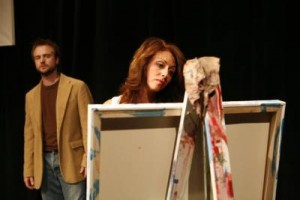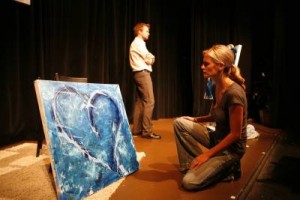
In Act 1, three relationships break up. In Act 2, the same six individuals begin anew,
but with different partners. A clever “why hasn’t that been done before?” premise,
skillfully executed in Kristen Lasarian’s world premiere play Love Like Blue.
Couple number 1 is Carissa (Sandra Purpuro) and Eddie (Josh Daugherty). Carissa is
a self-involved artist whom we first see painting at her easel, her brushstrokes
passionate, almost violent, as loud music plays in the background. The sudden
appearance of her boyfriend Eddie provokes a piercing scream from Carissa and the
angry complaint that it was like having the “best sex dream interrupted right before
orgasm.” Eddie is soaking wet, having waited in the pouring rain for Carissa to arrive
for their movie date, and pissed as all get out. Carissa blithely explains that she did
get in her car but suddenly realized that her painting “needed blue.” This is the final
straw for college prof Eddie, who cares not a whit that painting “saves” Carissa,
that it’s “the one thing that keeps (her) from losing it.” Like Barbra Streisand before
him, Eddie believes that people need other people, while Carissa’s response to
everything seems to be a self-absorbed if unstated “Whatever…” Eventually, Eddie
realizes that “there’s no good reason for me to be waiting for you.” End of couple
number 1.
Couple number 2 is Sarah (Heidi Brook Myers) and her husband Nolan (Bryan
Rasmussen). Sarah is setting the table (with her wedding china) for an elegant at-
home dinner for two, apparently the first one in their four years of marriage. “I finally
got around to reading the oven instructions,” she tells Nolan, who is taken aback
when she starts peppering him with questions about his first marriage, to a woman
named Rhea. “Do you think of her?” Sarah wants to know. ”Do you miss her? Maybe
get a little pang?” We soon realize that Sarah is serving only “pretend” food and
wine. The table, she tells Nolan, is pretty, and empty, “like us.” Not only that, but
today she happened to run into Rhea, who recognized Sarah’s ring as the same one
Nolan had given her originally. With this insensitive straw, the camel’s back has been
broken. “I want a divorce,” she tells Nolan. “I don’t love you anymore. I don’t plan
on missing you.” End of couple number 2
Couple number 3 is Wynne (Megan Tropea) and Felix (Warren Davis). It’s 4 a.m. and
Felix is asleep in front of his laptop in their New York high-rise apartment, where he
has been attempting to work on a novel about his relationship with Wynne. Wynne
enters the room, intending to go out for a walk. It turns out (unbeknownst to Felix)
that she often gets up at 4:00 and then goes back to bed before sunrise. The one-
time drug addict tells Felix, “I get up at 4:00 so that I can feel something. It think it’s
God.” Though Felix reiterates his love for Wynne, who has been his muse, she can
only reply, “Stop saying you love me. I can’t stand it. You just desire me, want to
possess me. I can’t let you talk me into love.” At first Felix loved it that she made him
“lose (his) grounding,” but now he just wants the “realness of life,” something which
Wynne cannot give him. There is no hope for this couple either. End of couple
number 3. End of act one.
And that’s all you’ll hear from me about the plot. If you want to find out who ends
up coupled with whom in Act 2, you’ll have to see Love Like Blue, something which I
highly recommend, as playwright Lazarian has created six very real, imperfect,
intriguing, and human characters. Former child actor Moosie Drier has turned into
one fine adult director, guiding his amazing cast of six to some truly outstanding
work. Lazarian’s dialog is so good, so real, so natural, that it almost acts itself, though
one cannot minimize the talent of the six actors who bring it so vividly to life.
Daugherty, Davis, Purpuro, Myers, Rasmussen, and Tropea are each of them as good
as it gets, though special mention must be made of the truly electric work done by
Sandra Purpuro (who lucks out with the most emotional, volatile role). Purpuro, a
Broadway vet, equally at home in musicals (she’s also appearing in Cesar and
Ruben) as dramas (Salsa Saved the Girls), is like a force of nature as Carissa, giving a
terrifically spontaneous performance.
One of the reasons that Love Like Blue works so well is its brilliantly original concept.
We get to know all six people in act 1, but we see them at their worst, at their
cruelest, at their most disillusioned. Then, as the deck is reshuffled in act 2, we
rediscover them at their best, fresh, excited, optimistic, ready to love again. Love
Like Blue brings back to us the pain of a breakup, at the same time reminds us why
we keep jumping back into the dating pool again and again. As one character
puts it, “I’m prepared to love again, better than before.”
Love Like Blue is playing at the Whitefire on “off nights” (Wednesdays and Thursdays),
and the set of the concurrently running Mustang Sally is hidden behind black felt
curtains. In front of them, Elizabeth Lowrie has designed three simple but effective
“rooms.” Basically three sets of furniture, what turns them into a very effective “set
design” is the large hanging “window” on which is brightly projected one of Carissa’s
paintings in the first scene, a suburban landscape in the second, and the New York
skyline in the third. Carissa talks about “love like blue,” blue being for her the color of
love, its many shades representing the many types and stages of love. The blue
motif is carried out in Lowrie’s set props, which include a blue bath towel, blue wine
glasses, blue candles, a blue coffee cup, a blue cigarette pack, and three beautiful
blue oil paintings by Donna Marie Kent. Lesley Fairman has designed lighting to fit
the “blue” mood of each scene.
Love Like Blue bills itself a “dark romantic comedy,” though I’d be far more inclined
to call it a drama, which lightens up considerably (and as one might expect) in the
upbeat second act. Nomenclature aside, Love Like Blue is a very good play
performed by six very talented actors and definitely worth missing a Wednesday or
Thursday evening of TV for.
Whitefire Theatre, 13500 Ventura Boulevard, Sherman Oaks.
www.whitefiretheatre.com
–Steven Stanley
October 25, 2007




 Since 2007, Steven Stanley's StageSceneLA.com has spotlighted the best in Southern California theater via reviews, interviews, and its annual StageSceneLA Scenies.
Since 2007, Steven Stanley's StageSceneLA.com has spotlighted the best in Southern California theater via reviews, interviews, and its annual StageSceneLA Scenies.







 COPYRIGHT 2025 STEVEN STANLEY :: DESIGN BY
COPYRIGHT 2025 STEVEN STANLEY :: DESIGN BY